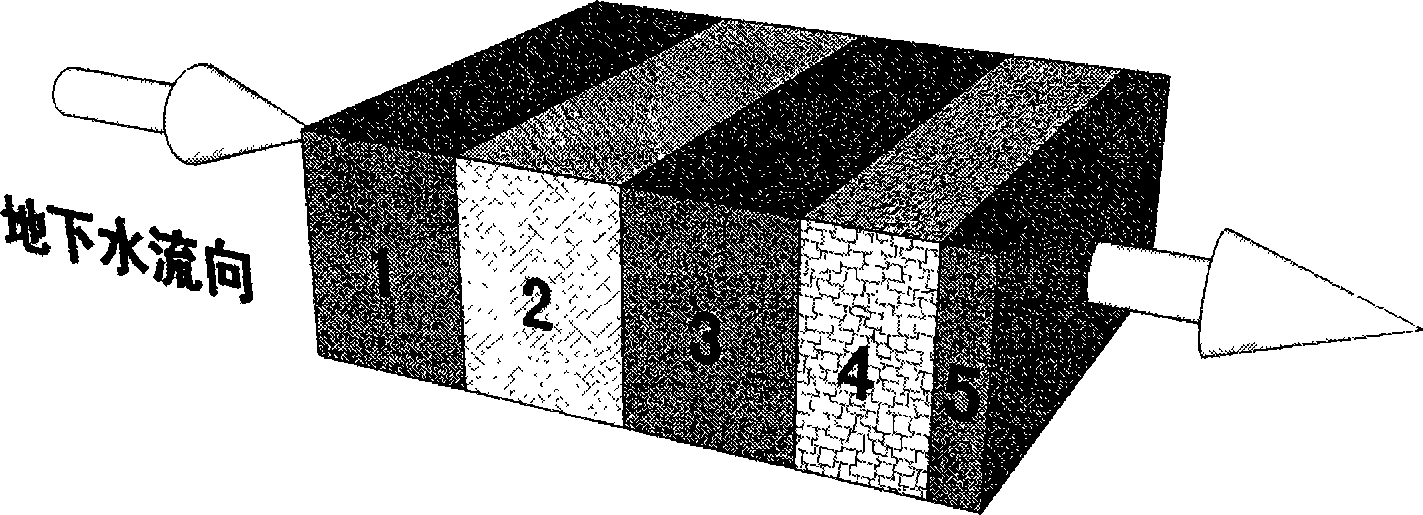Method for renovating groundwater in situ with chemical and biological composite reaction wall
A technology of combined reaction and chemical reaction, applied in chemical instruments and methods, biological water/sewage treatment, contaminated groundwater/leachate treatment, etc.
- Summary
- Abstract
- Description
- Claims
- Application Information
AI Technical Summary
Problems solved by technology
Method used
Image
Examples
Embodiment 1
[0041] The combined reaction wall includes a chemical reaction wall 2 with a thickness of 50 cm in the upstream of the groundwater flow, and a biological reaction wall 4 with a thickness of 30 cm in the downstream of the chemical reaction wall 2 at 50 cm.
[0042] The screening and domestication of nitrobenzene-degrading bacteria and aniline-degrading bacteria include the following methods and steps:
[0043] a, the screening of bacterial classification, get two parts of chemical plant blowdown outlet bottom mud, each 10ml, place respectively in the 250ml Erlenmeyer flask that glass beads and 90ml distilled water are housed, after oscillating and aerating 24 hours in 10°C constant temperature oscillator, Take 10ml of each and inoculate them in the culture solution containing aniline or nitrobenzene, and then culture for 48 hours to obtain the strains of aniline or nitrobenzene;
[0044] b. Domestication of aniline-degrading bacteria, put the strains in a 250ml Erlenmeyer flask...
Embodiment 2
[0068] Dig a deep ditch 30 cm wide in the upstream of the groundwater flow direction, and the depth reaches the underground water-resisting layer, mix zero-valent iron and activated carbon in a ratio of 5:1, and fill it in after mixing, which is the chemical reaction wall 2. The original concentration of nitrobenzene was 300.87 mg / L, and nitrobenzene was not detected until the 10th day after running through the chemical reaction wall, which indicated that nitrobenzene had been completely reduced by zero-valent iron and adsorbed by activated carbon within 10 days. As time increases, the concentration of nitrobenzene increases slightly, which shows that the adsorption of activated carbon in the iron-carbon layer has reached saturation, and the reducing performance of iron has decreased, so nitrobenzene appears, and nitrobenzene reaches 1.4mg / L-1.6mg / L. Experiments have proved that the conversion rate of p-nitrobenzene in the chemical reaction wall is 99%.
[0069] At the downst...
PUM
 Login to View More
Login to View More Abstract
Description
Claims
Application Information
 Login to View More
Login to View More - R&D
- Intellectual Property
- Life Sciences
- Materials
- Tech Scout
- Unparalleled Data Quality
- Higher Quality Content
- 60% Fewer Hallucinations
Browse by: Latest US Patents, China's latest patents, Technical Efficacy Thesaurus, Application Domain, Technology Topic, Popular Technical Reports.
© 2025 PatSnap. All rights reserved.Legal|Privacy policy|Modern Slavery Act Transparency Statement|Sitemap|About US| Contact US: help@patsnap.com

